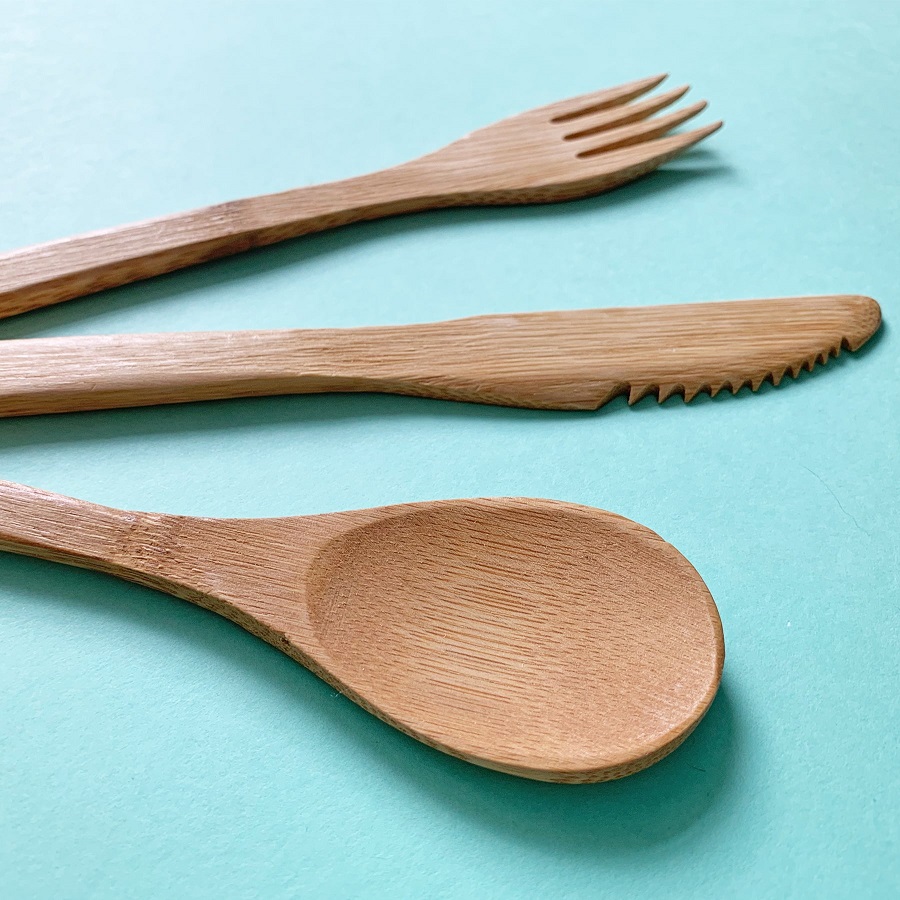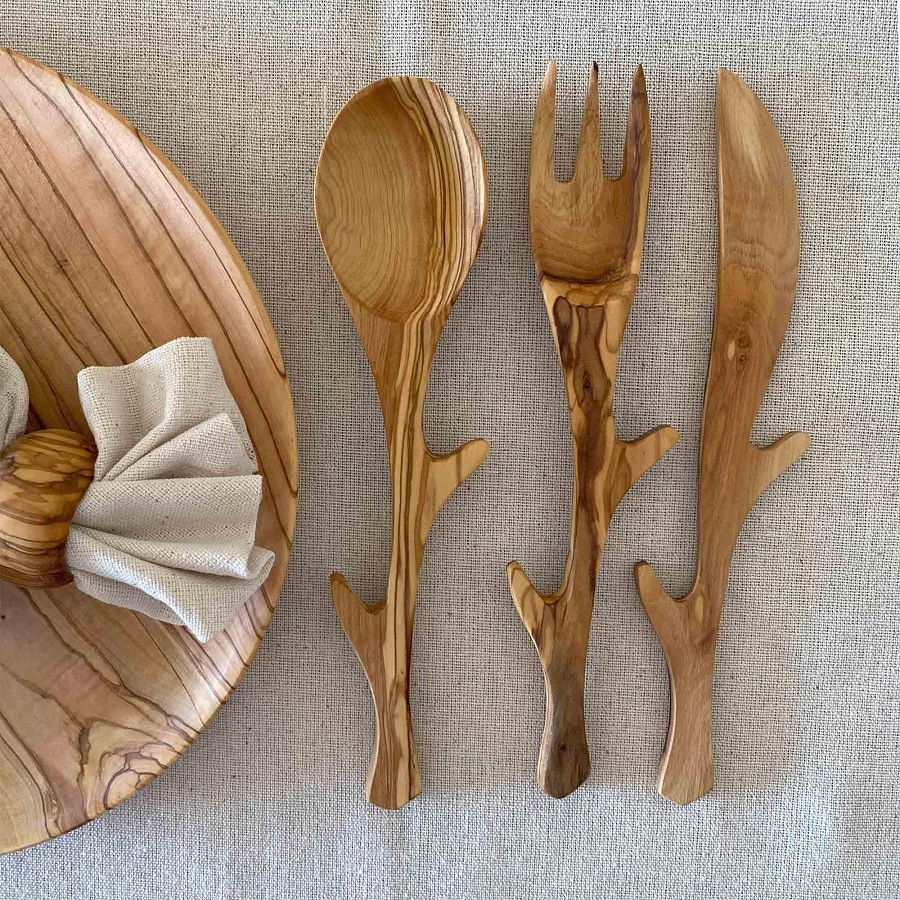The Environmental Impact of Plastic Cutlery
The use of plastic cutlery has harmful impacts on the environment. Every year, millions of tons of plastic waste, including cutlery, end up in landfills. Here, they take centuries to decompose. Worse yet, a lot of this plastic waste enters the oceans, harming marine life. Sea creatures often mistake plastic for food, leading to ingestion and potentially death.
Plastic is made from non-renewable resources. Its production involves the emission of greenhouse gases, which contribute to climate change. Once used, plastic cutlery is difficult to recycle. Many recycling centers don’t accept them due to contamination risk and sorting challenges.
Single-use plastic cutlery also adds to the growing problem of plastic pollution. These items often find their way into natural habitats, where they break down into microplastics. These tiny particles permeate ecosystems, posing a risk to wildlife and human health.
Using wooden cutlery is a step towards reducing these environmental harms. As more people become aware of these issues, the shift to sustainable options like cutlery is gaining momentum.
 Advantages of Using Wooden Cutlery
Advantages of Using Wooden Cutlery
The shift towards cutlery comes with multiple benefits, both environmentally and for personal health.
Biodegradable and Compostable: Unlike plastic, cutlery breaks down naturally. When disposed of, it can become part of the compost, contributing to soil health rather than polluting the environment. This process takes months instead of centuries, as is the case with plastic.
Sustainable Resources: Wooden cutlery often comes from renewable sources. Trees are planted to create more raw materials for wooden cutlery. This cycle is far more sustainable compared to the finite resources needed for plastic.
Chemical-Free: Wooden cutlery doesn’t have the same harmful chemicals found in plastic wares, such as BPA. This makes them safer for human use, especially when considering that they touch the food we eat.
Energy Efficient Production: Producing cutlery uses less energy than making plastic cutlery. It results in a smaller carbon footprint and is less taxing on the environment.
Adds Aesthetic Value: Wooden cutlery has a natural, rustic charm. It can enhance the dining experience by adding a touch of elegance and simplicity that plastic cutlery doesn’t offer.
Encourages Responsible Behavior: Choosing cutlery sends a positive message. It reflects a commitment to sustainability and influences others to make eco-friendly choices.
By incorporating cutlery, individuals and businesses participate in a global effort. They are reducing waste, protecting wildlife, and promoting ecological balance.
Different Types of Wooden Cutlery
When exploring the world of wooden cutlery, we uncover a variety of types, each with distinct features catering to different uses and preferences. Wooden cutlery is not just limited to the common fork, knife, and spoon; there are numerous designs, each crafted to enhance the dining experience while staying eco-friendly. Here are some of the most popular types of wooden cutlery:
- Bamboo Cutlery: Bamboo is a highly renewable material and is known for its strength and durability. Bamboo cutlery is lightweight yet sturdy, making it a favorite amongst those looking for sustainable dining options.
- Birchwood Cutlery: Birchwood is another popular choice for cutlery, renowned for its smooth finish and resistance to splintering. This type of cutlery is often used in both casual and formal dining settings.
- Disposable Wooden Cutlery: Ideal for picnics, parties, or food trucks, disposable wooden cutlery provides an eco-conscious alternative to plastic while still offering convenience.
- Reusable Wooden Cutlery: For those aiming to reduce waste further, reusable cutlery sets, which can be washed and used multiple times, are an excellent investment.
- Specialty Utensils: Apart from the standard tableware, cutlery also comes in the form of chopsticks, spreaders, tongs, and even sporks. These specialty items cater to diverse cultural dishes and eating habits.
Each type of wooden cutlery has its place in the vast tableau of sustainable dining. From the picnic blanket to the fine dining table, wooden cutlery proves to be an adaptable, environmentally friendly choice. Choosing the right type depends on one’s lifestyle, needs, and commitment to sustainable practices. With cutlery, one can enjoy the meal guilt-free, knowing that each bite contributes to a healthier planet.
How Wooden Cutlery is Made
Wooden cutlery making is a blend of traditional craftsmanship and modern technology. Here’s a step-by-step look at the process:
Selection of Wood: Manufacturers begin by choosing the right type of wood. Bamboo and birch are popular for their durability and sustainability. The wood must be renewable and harvested responsibly.
Cutting and Shaping: Next, logs or bamboo shoots are cut into smaller pieces. High-precision machines or hand tools carve these pieces into the familiar shapes of forks, spoons, and knives.
Sanding and Polishing: The cutlery then undergoes sanding to smooth edges and surfaces. Polishing follows to give the utensils their final appearance and to minimize splintering.
Quality Control: Each piece of cutlery is inspected for flaws. Manufacturers check for uniformity, durability, and splinters to ensure safety and quality.
Packaging: Finally, the cutlery is packaged. Packaging is often made from eco-friendly materials to align with the product’s sustainable ethos.
Throughout the process, the goal is to minimize waste and energy use. Wooden cutlery makers often use sawdust and wood scraps for other products or as a biofuel. With every step, care is taken to uphold eco-friendly principles while delivering a durable, attractive product.
The Role of Wooden Cutlery in Eco-Friendly Restaurants
Wooden cutlery is revolutionizing the dining scene, especially in eco-friendly restaurants. As sustainability becomes a priority, these restaurants champion the use of cutlery to align with their green missions.
Emphasizes Commitment to Sustainability: By offering cutlery, eco-friendly restaurants underscore their dedication to protecting the environment. It signals to customers that the business takes responsibility for its environmental footprint.
Enhances Customer Experience: Patrons of eco-conscious eateries appreciate the initiative. They enjoy the natural feel of wooden cutlery over plastic. It adds to a wholesome dining experience.
Reduces Plastic Waste: Eco-friendly restaurants aim to decrease their waste output. Switching to wooden cutlery greatly cuts down the volume of non-biodegradable waste.
Supports Sustainable Practices: By using wooden cutlery, restaurants support sustainable forestry and responsible manufacturing. They become part of a larger eco-friendly supply chain.
Meets Consumer Expectations: A growing number of diners prefer sustainable dining options. Restaurants meet this demand with wooden cutlery, appealing to a more environmentally conscious clientele.
Potential for Brand Differentiation: Restaurants using cutlery stand out. They show innovation and a commitment to future trends in sustainable dining. This can set them apart in a competitive market.
Wooden cutlery in eco-friendly restaurants does more than just replace plastic. It’s a symbol of the establishment’s values and a step towards a healthier planet. These restaurants serve as role models, inspiring others in the industry to make eco-conscious choices.
Maintaining and Disposing of Wooden Cutlery
Daily Care and Maintenance
Proper maintenance of wooden cutlery is important. It helps extend its lifespan. For daily care, hand washing is best. Use mild soap and warm water. Avoid soaking in water to prevent cracking and warping. After washing, dry wooden utensils immediately. Stand them up to air dry completely. Once dry, store in a dry place. On occasion, rub with food-grade mineral oil. This helps maintain the wood’s natural beauty. It keeps the cutlery from drying out.
Eco-Friendly Disposal Methods
When it’s time to dispose of wooden cutlery, do so responsibly. Wooden cutlery is biodegradable. It can be composted at home or in industrial facilities. Before composting, remove any non-compostable residues. If composting is not an option, use them for gardening needs. Broken utensils can support plant growth. They work as markers or stakes. Wooden cutlery can also be repurposed. Use them for crafts or as stirrers for paint. If none of these options work, check with local recycling programs. Some may accept cutlery.
Legislation and Policies Promoting Wooden Cutlery Use
Around the globe, governments are recognizing the need for sustainable practices. Many are taking action by enforcing legislation and policies to reduce plastic use. Promoting wooden cutlery is part of this green wave.
Bans on Single-Use Plastics: Some countries have banned single-use plastics. This shift has paved the way for alternatives like wooden cutlery to rise in popularity.
Incentives for Sustainable Products: In efforts to promote green business, governments often offer tax reliefs and incentives. Businesses using products like cutlery might benefit.
Educational Campaigns: Public awareness campaigns play a role. They inform citizens about the benefits of using sustainable products such as wooden cutlery.
Support for Green Initiatives: Governments may fund programs that encourage sustainable dining. This support helps drive the adoption of eco-friendly products, including cutlery.
Regulations for Responsible Sourcing: Some policies ensure cutlery comes from renewable sources. They mandate responsible forestry practices.
These efforts help create a market for cutlery. They encourage consumers and businesses to make eco-friendlier choices. Wooden cutlery has become more than just an option. It is a symbol of commitment to the planet’s health. Policy support has the power to transform habits and industries. As a result, we can expect more eco-friendly dining landscapes in the future.
Future Trends in Sustainable Dining and Cutlery
Sustainable dining is evolving. The use of wooden cutlery is a clear reflection of this change. As interest in eco-friendly practices grows, so do the trends shaping the future of dining and cutlery. Here are some future trends we can expect to see:
- Increased Use of Plant-Based Materials: Wooden cutlery might soon see company from other plant-based materials. Expect innovative alternatives from sources like cornstarch or avocado seeds.
- Customizable and Branded Cutlery: Companies may offer personalized cutlery. This can help brands to stand out and display their eco-commitment.
- Technological Enhancements: Future cutlery might come with features like natural antibacterial coatings. This would further ensure the safety and longevity of the products.
- Expanded Composting Programs: Cities may expand composting facilities to accommodate biodegradable cutlery, making disposal even easier for users.
- Legislation Support: New laws will likely further limit plastic use. They will continue to back alternatives like cutlery. Tax incentives for businesses using sustainable practices might become more commonplace.
- Consumer Demand Shift: Awareness will drive more consumers to demand sustainable options, leading to a wider adoption of cutlery in all dining scenarios.
- Integration with Tech: Apps could track the impact of one’s dining habits on the environment. This integration can incite more people to choose sustainable cutlery options.
These trends offer a glimpse into a future where dining is not only about flavor but also about values. Wooden cutlery is at the forefront, leading the charge towards a more sustainable dining experience.



